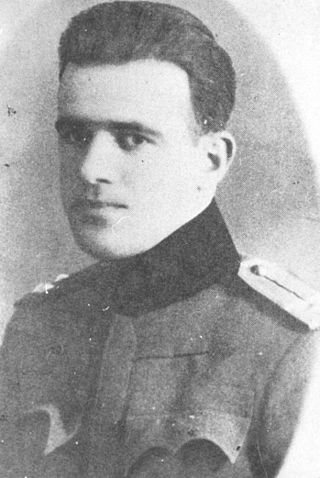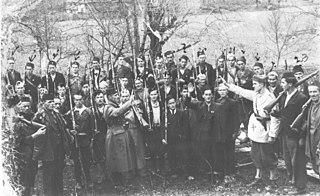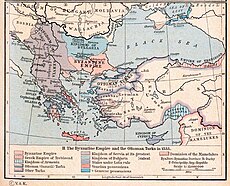
The Territory of the Military Commander in Serbia was the area of the Kingdom of Yugoslavia that was placed under a military government of occupation by the Wehrmacht following the invasion, occupation and dismantling of Yugoslavia in April 1941. The territory included only most of modern central Serbia, with the addition of the northern part of Kosovo, and the Banat. This territory was the only area of partitioned Yugoslavia in which the German occupants established a military government. This was due to the key rail and the Danube transport routes that passed through it, and its valuable resources, particularly non-ferrous metals. On 22 April 1941, the territory was placed under the supreme authority of the German military commander in Serbia, with the day-to-day administration of the territory under the control of the chief of the military administration staff. The lines of command and control in the occupied territory were never unified, and were made more complex by the appointment of direct representatives of senior Nazi figures such as Reichsführer-SS Heinrich Himmler, Reichsmarschall Hermann Göring, and Reichsminister Joachim von Ribbentrop. The Germans used Bulgarian troops to assist in the occupation, but they were at all times under German control. Sources variously describe the territory as a puppet state, a protectorate, a "special administrative province", or describe it as having a puppet government. The military commander in Serbia had very limited German garrison troops and police detachments to maintain order, but could request assistance from a corps of three divisions of poorly-equipped occupation troops.
The Grand Anti-Masonic Exhibition was the name of an antisemitic exhibition that was opened on October 22, 1941 during World War II in Belgrade, the capital of the Nazi Germany-established Militärverwaltung in occupied Serbia.

The Serbian State Guard, also known as the Nedićevci, was a collaborationist paramilitary force used to impose law and order within the German occupied territory of Serbia during World War II. It was formed from two former Yugoslav gendarmerie regiments, was created with the approval of the German military authorities, and for a long period was controlled by the Higher SS and Police Leader in the occupied territory. It assisted the Germans in imposing one of the most brutal occupation regimes in occupied Europe and helped guard and execute prisoners at the Banjica concentration camp in Belgrade. Its leaders and much of the rank and file were sympathetic to the Chetnik movement of Draža Mihailović, and it was purged by the Germans on several occasions for that reason. In October 1944, as the Soviet Red Army closed on Belgrade, the SDS was transferred to Mihailović's control by a member of the fleeing Nedić administration, but it quickly disintegrated during its withdrawal west, with only a small number of former SDS members being captured by the British near the Italian-Yugoslav border in May 1945.

The Crveni Krst concentration camp, also known as the Niš concentration camp, located in Crveni Krst, Niš, was operated by the German Gestapo and used to hold captured Serbs, Jews and Romanis during the Second World War. Established in mid-1941, it was used to detain as many as 35,000 people during the war and was liberated by the Yugoslav Partisans in 1944. More than 10,000 people are thought to have been killed at the camp. After the war, a memorial to the victims of the camp was erected on Mount Bubanj, where many inmates were shot. A memorial museum was opened on the former campgrounds in 1967 and in 1979 the campgrounds were declared a Cultural Monument of Exceptional Importance and came under the protection of the Socialist Republic of Serbia.

The Banat was a political entity established in 1941 after the occupation and partition of Yugoslavia by the Axis Powers in the historical Banat region. It was formally under the control of the German puppet Government of National Salvation in Belgrade, which theoretically had limited jurisdiction over all of the Territory of the Military Commander in Serbia, but all power within the Banat was in the hands of the local minority of ethnic Germans (Volksdeutsche). The regional civilian commissioner and head of the ethnic German minority was Josef Lapp. Following the ousting of Axis forces in 1944, this German-ruled region was dissolved and most of its territory was included into Vojvodina, one of the two autonomous provinces of Serbia within the new SFR Yugoslavia.
The Russian Protective Corps was an armed force composed of anti-communist White Russian émigrés that was raised in the German occupied territory of Serbia during World War II. Commanded for almost its whole existence by Lieutenant General Boris Shteifon, it served primarily as a guard force for factories and mines between late 1941 and early 1944, initially as the "Separate Russian Corps" then Russian Factory Protective Group. It was incorporated into the Wehrmacht on 1 December 1942 and later clashed with the communist-led Yugoslav Partisans and briefly with the Chetniks. In late 1944, it fought against the Red Army during the Belgrade Offensive, later withdrawing to Bosnia and Slovenia as the German forces retreated from Yugoslavia and Greece. After Shteifon′s death in Zagreb, the Independent State of Croatia, on 30 April 1945, Russian Colonel Anatoly Rogozhin took over and led his troops farther north to surrender to the British in southern Austria. Unlike most other Russian formations that fought for Nazi Germany, Rogozhin and his men, who were not formally treated as Soviet citizens, were exempt from forced repatriation to the Soviet Union and were eventually set free and allowed to resettle in the West.

The Italian governorate of Montenegro existed from October 1941 to September 1943 as an occupied territory under military government of Fascist Italy during World War II. Although the Italians had intended to establish a quasi-independent Montenegrin kingdom, these plans were permanently shelved after a popular uprising in July 1941. Following the Italian surrender in September 1943, the territory of Montenegro was occupied by German forces which withdrew in December 1944.

Konstantin "Kosta" Milovanović Pećanac was a Serbian and Yugoslav Chetnik commander (vojvoda) during the Balkan Wars, World War I and World War II. Pećanac fought on the Serbian side in both Balkan Wars and World War I, joining the forces of Kosta Vojinović during the Toplica uprising of 1917. Between the wars he was an important leader of Chetnik veteran associations, and was known for his strong hostility to the Yugoslav Communist Party, which made him popular in conservative circles. As president of the Chetnik Association during the 1930s, he transformed it into an aggressively partisan Serb political organisation with over half a million members. During World War II, Pećanac collaborated with both the German military administration and their puppet government in the German-occupied territory of Serbia.

The Battle of Loznica involved an attack on the German garrison of that town by the Jadar Chetnik Detachment on 31 August 1941. Following the World War II German-led Axis invasion of Yugoslavia in April 1941, the Kingdom of Yugoslavia was partitioned. At the time, Loznica was part of the German-occupied territory of Serbia, which included Serbia proper, with the addition of the northern part of Kosovo, and the Banat.

Pavle Đurišić was a Montenegrin Serb regular officer of the Royal Yugoslav Army who became a Chetnik commander (vojvoda) and led a significant proportion of the Chetniks in Montenegro during World War II. He distinguished himself and became one of the main commanders during the popular uprising against the Italians in Montenegro in July 1941, but later collaborated with the Italians in actions against the Communist-led Yugoslav Partisans. In 1943, his troops carried out several massacres against the Muslim population of Bosnia, Herzegovina, and the Sandžak in which an estimated 10,000 people were killed between January and March, including thousands of women, children, and the elderly. He then led his troops during their participation in the anti-Partisan Case White offensive alongside Italian forces. Đurišić was captured by the Germans in May 1943, escaped, and was recaptured.

During World War II, the Kingdom of Hungary engaged in the military occupation, then annexation, of the Bačka, Baranja, Međimurje and Prekmurje regions of the Kingdom of Yugoslavia. These territories had all been under Hungarian rule prior to 1920, and had been transferred to Yugoslavia as part of the post-World War I Treaty of Trianon. They now form part of several states: Yugoslav Bačka is now part of Vojvodina, an autonomous province of Serbia, Yugoslav Baranja and Međimurje are part of modern-day Croatia, and Yugoslav Prekmurje is part of modern-day Slovenia. The occupation began on 11 April 1941 when 80,000 Hungarian troops crossed the Yugoslav border in support of the German-led Axis invasion of Yugoslavia that had commenced five days earlier. There was some resistance to the Hungarian forces from Serb Chetnik irregulars, but the defences of the Royal Yugoslav Army had collapsed by this time. The Hungarian forces were indirectly aided by the local Volksdeutsche, the German minority, which had formed a militia and disarmed around 90,000 Yugoslav troops. Despite only sporadic resistance, Hungarian troops killed many civilians during these initial operations, including some Volksdeutsche. The government of the newly formed Axis puppet state, the Independent State of Croatia, subsequently consented to the Hungarian annexation of the Međimurje area, which dismayed the Croat population of the region.
The Government of National Salvation, also referred to as Nedić's government or Nedić's regime, was the colloquial name of the second Serbian collaborationist puppet government established after the Commissioner Government in the German-occupied territory of Serbia during World War II in Yugoslavia. Appointed by the German Military Commander in Serbia, it operated from 29 August 1941 to 4 October 1944. Unlike the Independent State of Croatia, the regime in occupied Serbia was never accorded status in international law and did not enjoy formal diplomatic recognition of the Axis powers.
The Commissioner Government was a short-lived Serbian collaborationist puppet government established in the German-occupied territory of Serbia within the Axis-partitioned Kingdom of Yugoslavia during World War II. It operated from 30 April to 29 August 1941, was headed by Milan Aćimović, and is also referred to as the Commissars Government or Council of Commissars. Of the ten commissioners, four had previously been ministers in various Yugoslav governments, and two had been assistant ministers. The members were pro-German, anti-semitic and anti-communist, and believed that Germany would win the war. The Aćimović government lacked any semblance of power, and was merely an instrument of the German occupation regime, carrying out its orders within the occupied territory. Under the overall control of the German Military Commander in Serbia, supervision of its day-to-day operations was the responsibility of the chief of the German administrative staff, SS-Brigadeführer and State Councillor Harald Turner. One of its early tasks was the implementation of German orders regarding the registration of Jews and Romani people living in the territory, and the placing of severe restrictions on their liberty.

Franz Neuhausen was a wealthy industrialist who became the special plenipotentiary for economic affairs in the Territory of the Military Commander in Serbia during most of the German military occupation of that region of the partitioned Kingdom of Yugoslavia during World War II. He worked as a representative of Germany and the Nazi Party in Belgrade throughout the 1930s, during which he amassed a huge fortune. As a close friend and personal favourite of Reichsmarshall Hermann Göring, he became Göring's direct representative for the Four Year Plan in the occupied territory, and was its virtual economic dictator from April 1941 until August 1944. On 18 October 1943 he succeeded Harald Turner as the Chief of the Military Administration in Serbia, and he continued to fulfill both roles until late August 1944.

Vojislav Lukačević was a Serbian Chetnik commander in the Kingdom of Yugoslavia during World War II. At the outbreak of war, he held the rank of captain of the reserves in the Royal Yugoslav Army.

Lieutenant Colonel Zaharije Ostojić was a Montenegrin Serb and Yugoslav military officer who served as the chief of the operational, organisational and intelligence branches of the Chetnik Supreme Command led by Draža Mihailović in Yugoslavia during World War II. He was a major in the Royal Yugoslav Army Air Force prior to the Axis invasion of Yugoslavia, and was involved in the coup that deposed Prince Paul of Yugoslavia on 27 March 1941. After the coup, he escorted Prince Paul to exile in Greece, and was in Cairo during the invasion in April. In September 1941, he was landed on the coast of the Italian governorate of Montenegro along with the British Special Operations Executive officer Captain Bill Hudson and two companions. He escorted Hudson to the German-occupied territory of Serbia and introduced him to the Yugoslav Partisan leader Josip Broz Tito at Užice, then accompanied Hudson to Ravna Gora to meet Mihailović. Ostojić soon became Mihailović's chief of staff, and after the German attempt to capture the Chetnik leader during Operation Mihailovic in December 1941, brought the Chetnik Supreme Command staff to Montenegro where they were re-united with Mihailović in June 1942. During the remainder of 1942, Ostojić launched a counter-attack against Ustaše troops of the Independent State of Croatia returning to the eastern Bosnian town of Foča where they were expected to continue their genocidal anti-Serb policies. As many as 2,000 local Muslims were subsequently killed in the town by forces under Ostojić's command. Ostojić later oversaw large-scale massacres of civilians and burning of Muslim villages in the border region between Montenegro and the Sandžak.

During World War II, an area of the Kingdom of Yugoslavia previously occupied as the Italian governorate of Montenegro was occupied by German forces after the September 1943 Armistice of Cassibile, in which the Kingdom of Italy capitulated and joined the Allies. Italian forces retreated from the governorate, and from neighbouring Albania. German forces occupied Montenegro immediately, along with Albania, and the territory remained under German occupation until they and many of their local collaborators withdrew in December 1944.

The Sandžak Muslim militia was established in Sandžak and eastern Herzegovina in Axis occupied Yugoslavia between April or June and August 1941 during World War II. It was under control of the Independent State of Croatia until September 1941, when Italian forces gradually put it under their command and established additional units not only in Sandžak, but in eastern Herzegovina as well. After the capitulation of Italy in September 1943 it was put under German control, while some of its units were merged with three battalions of Albanian collaborationist troops to establish the "SS Polizei-Selbstschutz-Regiment Sandschak" under command of the senior Waffen SS officer Karl von Krempler.

Einsatzgruppe Serbia, initially named Einsatzgruppe Yugoslavia, was a German Schutzstaffel (SS) grouping in the German-occupied territory of Serbia during World War II. Directly responsible to the Reich Security Main Office in Berlin, EG Serbia consisted of representatives of the various offices of the RSHA, particularly Amt IV – the Gestapo, Amt V – the Kriminalpolizei, and Amt VI – the Ausland-Sicherheitsdienst. It also controlled the 64th Reserve Police Battalion of the Ordnungspolizei. While formally responsible to the Military Commander in Serbia via the head of the administrative branch of the military headquarters of the occupied territory, the chief of EG Serbia reported directly to his superiors in Berlin.

The attack on Kruševac was an attack of Yugoslav rebels on Axis-held Kruševac in the German-occupied territory of Serbia which lasted between 23 and 27 September 1941 during World War II.




















